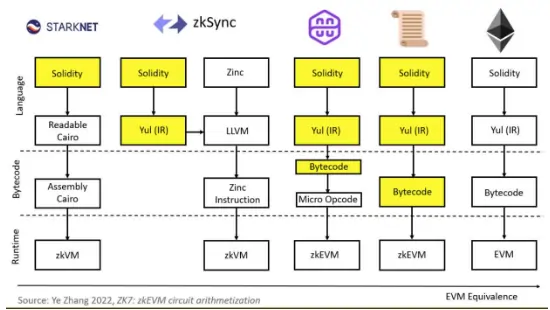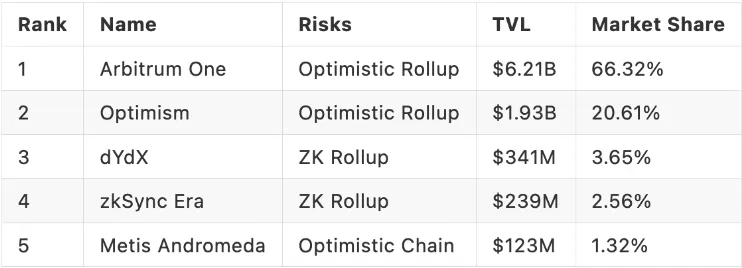
zkEVMs Beyond Polygon and zkSync
zkEVMs Beyond Polygon and zkSync
All zkEVMs are not created equal, and they are here to stay.
Intro
During the first quarter of 2023, the launch of zkSync and Polygon zkEVMs has drawn significant attention to the scalability properties of ZK technology for Ethereum. In this article, we will explore the main differences between these two platforms, as well as expand into two other zkEVM scaling solutions that are in the process of being brought to market.
Polygon and zkSync, the differences.
One key distinction between zkSync Era and Polygon zkEVM is their approach to EVM compatibility. zkSync Era is EVM compatible, meaning it uses its LLVM compiler to compile code from popular EVM languages such as Solidity, Vyper, and Yul to LLVM. Furthermore, zkSync Era has plans to expand its compiler to accept Rust and other high-level languages in the future, allowing developers to migrate EVM smart contracts without having to rewrite their code using a new language or tool.

Conversely, Polygon zkEVM is EVM equivalent at the bytecode level, meaning that most applications, tools, and infrastructure built on Ethereum can immediately port over to Polygon zkEVM with limited to no changes needed. This distinction makes zkSync Era closer to a Type 4 zkEVM, based on Vitalik’s framework, while Polygon zkEVM is currently a Type 3 zkEVM, with intentions to progress to a Type 2 zkEVM.
Another notable difference between the two platforms is their prover architecture. ZK Sync’s proving system is called Redshift for their FRI + PLONK construction. Though no public benchmarks exist for Redshift, an example of PLONK’s improvement over GROTH 16 can be seen in the table below, courtesy of Aztec:
On the other hand, Polygon’s zkEVM uses FFLONK. FFLONK does not require a trusted setup (only one universal setup). FFLONK can verify proofs on-chain cheaper than GROTH 16 and 30% cheaper than PLONK. Proof generation time is 10x slower than GROTH 16 with a proving time of ~ 2 min. However, SNARKs are only used in the last phase of recursion which batches multiple STARK proofs together.
When it comes to data availability, zkSync Era publishes state diffs to Ethereum, providing data compression and seamless integration with zkPorter, based on the Volition model by StarkWare. Meanwhile, Polygon zkEVM publishes transaction call data. A trade-off arises between the cost of verifying proofs, which need to be done faster when publishing only state diffs, vs the cost of publishing transaction data.
Indeed, there exist additional comparisons for both rollup protocols in terms of economic incentives for agents who operate the system, among other distinctions. Both teams have much to be proud of. Over the next few months it will be interesting to observe both teams driving adoption with liquidity mining incentives and/or strategic application partnerships that deliver daily active user volume.
What does Scroll bring to the table?
Scroll is a Type 2.5 zkEVM. Scroll’s architecture includes a sequencing node called the Scroll Node, a decentralized proving network called the Roller Network, and Rollup and Bridge Contracts for data availability and asset transfer between L1 and L2.
The Scroll Node is the main interface for applications and users to interact with Scroll, and it consists of three modules: the Sequencer, Coordinator, and the relayer.

- The Sequencer retrieves a batch of transactions from its mempool, generates a new L2 block, and a new state root.
- The Coordinator receives the execution trace of the new block, dispatches it to a randomly-selected Roller for proof generation, and aggregates the proofs into a single aggregate proof.
- The Relayer monitors the rollup contract for data availability and validity proof, and relays messages between Ethereum and Scroll.
The Rollup and Bridge Contracts connect Scroll to the Ethereum base layer. The Rollup contract stores state roots and block data in the Ethereum state for data availability and leverages Ethereum’s security to ensure block finality. The Bridge contracts allow users to pass messages and assets between L1 and L2 using a trust-minimised bridging protocol.
What’s Linea, Consensys zkEVM?
ConsenSys opened its EVM-equivalent zkEVM rollup to public testnet on March 28th, 2023.
During its private beta phase, over 490,000 transactions have been processed. One of the main features of its zkEVM is the innovative lattice-based prover, which offers leading performance in proof generation and results in cheap transaction fees.
The recursion-friendly, lattice-based zkSNARK prover is more performant than standard schemes and can be verified on the Ethereum mainnet. As part of ConsenSys’ commitment to open-source software, zkEVM is designed to be highly composable and compatible with other EVM-based applications. It uses ETH for gas and has no reliance on third-party transpilers or custom middleware, ensuring a secure and transparent solution for developers.
The market of scaling Ethereum
One key metric that reflects the success of a layer 2 solution is Total Value Locked. According to recent data from L2 Beat, zkSync has emerged quickly, capturing 2.56% of the $9.36B L2 market, surpassing all other general purpose ZK rollups. This is a promising indicator of zkSync’s user adoption.

Another important factor in evaluating the performance of layer 2 solutions is the fees generated on their networks. Token Terminal’s data indicates that Arbitrum dominated among layer 2 protocols, accounting for 41% of all L2 fees. On the other hand, Polygon POS and Optimism constituted 23% and 22% of the fees generated, respectively. This suggests that Arbitrum has achieved considerable market traction in terms of fee generation.
Conclusion
The zkEVM market is dynamic and competitive, with different players offering unique features and capabilities. This has significantly contributed to the ongoing conversation and development of Ethereum scaling solutions. With their unique approaches and features, these platforms offer promising options for developers and users seeking efficient and cost-effective solutions for scaling Ethereum.